Unrelated Donor StemCell Transplantation: The Role of the National Marrow Donor Program
Approximately 70% of patientswith life-threatening diseasestreatable with allogeneic bloodstem cell transplantation do not havematched related donors. The NationalMarrow Donor Program (NMDP) wasestablished in 1986 to provide humanleukocyte antigen (HLA)-matched,volunteer unrelated donors for thesepatients. The NMDP performs thistask by maintaining a registry of morethan 4.9 million volunteer donors ofmarrow and peripheral blood stemcells (PBSC) and 12 cord blood bankscontaining more than 25,000 units ofumbilical cord blood.
A
pproximately 70% of patientswith life-threatening diseasestreatable with allogeneic bloodstem cell transplantation do not havematched related donors. The NationalMarrow Donor Program (NMDP) wasestablished in 1986 to provide humanleukocyte antigen (HLA)-matched,volunteer unrelated donors for thesepatients. The NMDP performs thistask by maintaining a registry of morethan 4.9 million volunteer donors ofmarrow and peripheral blood stemcells (PBSC) and 12 cord blood bankscontaining more than 25,000 units ofumbilical cord blood.
Background
The NMDP is a nonprofit organizationthat operates the congressionallymandated National Bone MarrowDonor Registry under contract fromthe Health Resources Services Administration,a division of the US Departmentof Health and HumanServices. The NMDP Registry is thelargest, most diverse registry of potentialhematopoietic stem cell donorsin the world. To carry out its missionof providing HLA-matched stem cellsfor patients, the NMDP operates aworldwide network of medical organizationsthat cooperate together to locate,procure, and transport stem cellsto waiting patients.The wide range of medical organizationsin the NMDP network areshown in Table 1. The NMDP alsoprovides resources for patients and physicians,collects patient outcome data,and conducts research to improve theoutcomes of stem cell transplantation.

A graphic representation of theNMDP network is shown in Figure 1.The national coordinating center of theNMDP, located in Minneapolis, Minnesota,houses the computerized NMDPregistry of unrelated stem cell donors,including data on the inventories ofNMDP-affiliated cord blood banks.Searches of the NMDP Registry forHLA-matched donors or umbilicalcord blood units are accomplishedthrough secure electronic communicationsbetween the NMDP and itsnetwork of donor centers, apheresiscenters, collection centers, transplantcenters, and HLA laboratories.
The NMDP Registry
Stem cell transplants, whether relatedor unrelated, require preciseHLA matching between donor andpatient. Because HLA antigens areinherited, patients are more likely tofind a matching donor within theirown racial or ethnic communities. Toprovide patients of every ethnic communitya better chance at finding amatched donor, the NMDP has ongoingrecruitment programs to bringmore African-American, AmericanIndian/Alaska Native, Asian/PacificIslander, and Hispanic donors to theNMDP Registry. Currently, approximately31% of the volunteer donorslisted in the NMDP Registry are fromracial and ethnic minority groups.
NMDP Cord Blood Program
The NMDP currently lists more than25,000 units of donated umbilical cordblood from a growing partnership withcord blood banks. The addition of cordblood banks to the NMDP Networkwas vital to provide more transplantoptions for patients. All cord blood unitsat NMDP cord blood banks are listedin the NMDP Registry and are automaticallyincluded in every patientsearch. The NMDP's cord blood programis a clinical trial developed in1998 under an Investigational NewDrug application (IND) with the USFood and Drug Administration (FDA).The NMDP continues to work withexisting cord blood banks to establishnew contacts and list more cord bloodunits in the NMDP Registry.
NMDP Office of Patient Advocacy
The NMDP's Office of PatientAdvocacy (OPA) works with patientsto remove barriers to obtaining an unrelateddonor transplant. The OPAconnects patients to transplant-relatedresources, helps patients find a transplantcenter, and assists them withfinancial and insurance matters. Inaddition, the OPA assists patients, theirfamilies, and physicians with any concernsor questions they may have regardingan NMDP-facilitated searchand stem cell transplant.
NMDP Research Program
The NMDP collects detailed medicaldata on patients who receive atransplant from an NMDP donor.These data are part of a comprehensiveresearch database the NMDPmaintains to assist medical researchersin the field of unrelated stem celltransplantation. The NMDP researchprogram develops and promotes researchaimed at increasing opportunitiesfor and improving outcomes ofunrelated donor stem cell transplants.NMDP resources available to researchersinclude:
- The largest database of HLAtypedindividuals in the world (morethan 4.9 million volunteer donors).
- Outcome, histocompatibilitydata, donor search, and donation sideeffectsdata on approximately 90% ofthe more than 16,000 unrelated donorstem cell transplants the NMDP hascoordinated since 1987.
- The largest unrelated stem celldonor and recipient HLA database inthe world (more than 7,600 pairedsamples).
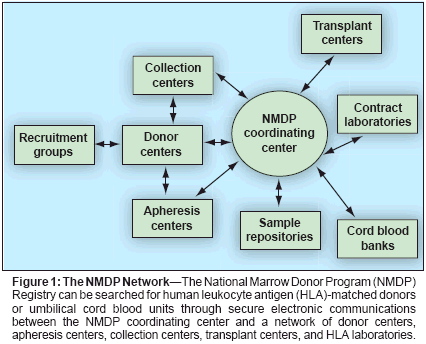
The NMDP, in collaboration withthe International Bone Marrow TransplantRegistry (IBMTR) and theEMMES Corporation, recently receiveda 5-year NIH grant to coordinate a newlyestablished Blood and Marrow TransplantClinical Research Network.Funding for this network is beingprovided by both the National Heart,Lung and Blood Institute and the NationalCancer Institute. When the networkbegins operations, a data coordinatingcenter will manage a nationalnetwork of centers performing clinicaltrials focused on hematopoietic stemcell transplantation. Additional goalsof the network include developingconsensus guidelines for diagnosing,monitoring, and grading importanttransplant-related end points, and thedevelopment and use of novel studydesigns to increase the efficiency andscientific validity of clinical trials inblood and marrow transplantation.
The NMDP and Unrelated DonorStem Cell Transplantation
Approximately 75% of the stemcell transplants facilitated by theNMDP are for patients with someform of leukemia. Indications for unrelateddonor stem cell transplant areconstantly changing. Since 1999,NMDP-facilitated transplants foradults with acute myelogenous leukemia have increased 66%, and transplantsfor myelodysplastic syndromeshave increased by 50%. Since thedevelopment of imatinib mesylate(Gleevec) to treat chronic myelogenousleukemia (CML), NMDP-facilitatedtransplants for CML havedecreased by 45%.
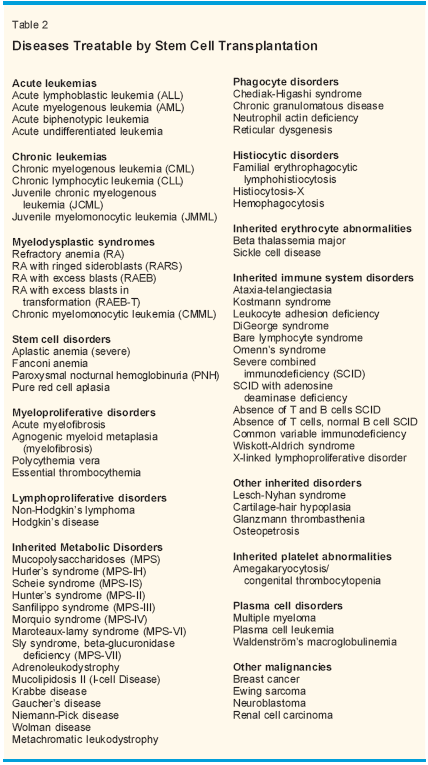
Current research is exploring theuse of reduced-intensity (nonmyeloablative)regimens in allogeneic stemcell transplantation. This has resultedin an increase in the number of stemcell transplants for non-Hodgkin'slymphoma, multiple myeloma, andhemoglobinopathies such as sickle celldisease.[1,2] Researchers are also investigatingthe use of stem cell transplantationin breast cancer[3,4] andrenal cell carcinoma.[3,5] Table 2shows the diseases for which unrelatedstem cell donor transplants havebeen performed by transplant centersin the NMDP Network
Obtaining an NMDP-FacilitatedStem Cell Transplant
Initiating a preliminary search ofthe NMDP Registry to locate an HLAmatcheddonor or umbilical cordblood is free and available to any physician.Interpreting the results of apreliminary search and efficientlymoving forward through the manysteps to a transplant requires an understandingof the clinical aspects ofstem cell transplantation and knowledgeof the operations of the NMDP.
The HLA System
Lymphocytes differentiate betweenself and nonself cells by examining theHLA antigens expressed on the surfaceof cells. To prevent graft rejection andother posttransplant complications,stem cell donors and recipients must beclosely HLA matched.[6]
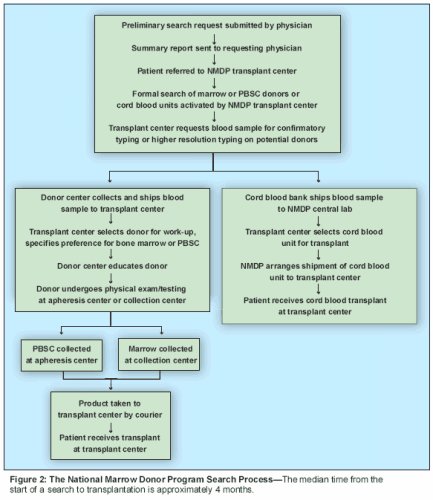
The HLA antigens are encoded onthe short arm of human chromosome 6,on a segment called the major histo-compatibility complex (MHC). Thereare 3.5 million bases in the MHC, butonly a small number are currentlymatched in stem cell transplantation.The relevant portions of the MHC arefurther divided into two regions-class I and class II. Class I antigens(HLA-A, -B, and -C) and class II antigens(HLA-DRB1, -DP, and -DQ)are the antigens most frequently examinedwhen matching potential stemcell donors and transplant recipients.
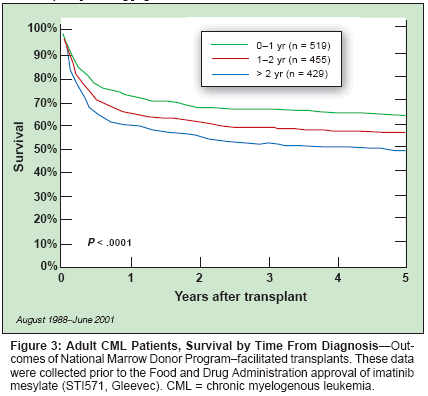
The NMDP requires that donors andpatients have no more than a one-antigenmismatch at the HLA-A, -B or-DRB1 locations. Because there are twoHLA antigens at each of these threelocations, a perfect match is referred toas a 6 of 6 match, and a one-antigenmismatch is termed a 5 of 6 match.Using this terminology, the NMDP willallow a 5/6 match or a 6/6 match formarrow and peripheral blood stem celltransplants, but not a 4/6 match or less.The NMDP will allow a 4/6 matchfor cord blood transplants, providedthe mismatched antigens are not atthe same loci. This less stringent HLAmatching for cord blood is permittedbecause of the lowered immunologiccompetence of cord blood T cells.[7-9]Some transplant centers require additionalmatching at the HLA-C, -DP,and/or DQ loci. Newer DNA-basedmethods of HLA typing have provento be more accurate than serologicmethods and have largely supersededthem.[10]
Impact of HLA Matchon Transplant Outcome
In allogeneic stem cell transplantation,the degree of donor/recipientHLA match is an important factor inengraftment, the development of graftvs-host disease (GVHD), and overallsurvival.[11,12] The association of HLAclass I allele disparity with graft failurewas examined by the Seattle group, whoretrospectively analyzed data from 21patients experiencing graft failure and42 case-matched controls. Complete allele-level matching for class I was identifiedin 45% of controls and 10% of graftfailure cases.[13]The effect of the number of HLA disparitieswas subsequently studied in unrelated-donor stem cell transplant forCML patients. Among allele-matcheddonors/recipients and donors/recipientsmismatched for a single class I allele,the graft failure rate was 2%. When twoor more class I disparities at HLA-A, -B,and/or -C were present, the graft failurerate increased to 29%.[14]In unrelated-donor stem cell transplantation,the risk of clinically significantGVHD is also influenced bythe extent of HLA disparity betweenthe donor and recipient. GVHD is apotentially life-threatening complicationinvolving an immunologic reactionin recipients that is mediated bythe transplanted T cells.
Searching the NMDP Registryfor an Unrelated Donor
Any physician can submit a preliminarysearch request free of charge bysubmitting to the NMDP the patient'sname and address, age, sex, race/ethnicgroup, disease diagnosis, disease status,and HLA typing results. TheNMDP strongly encourages that patientsbe HLA typed at A, B, and DRB1using DNA-based, allele-level typing,but serologic HLA typing results arealso accepted. The search result willyield more accurate lists of bestmatcheddonors when allele-level tissuetyping is performed on the patient.The search process is outlined inFigure 2. Because the median time fromthe start of a search to transplantation isapproximately 4 months, physicians areurged to start a search of the NMDPRegistry early in the treatment process,even if a stem cell transplant is not partof the immediate treatment planBy the next business day followingthe receipt of a preliminary search request,the NMDP returns a report viafax or mail to the requesting physicianshowing the potential donors on theNMDP Registry who are 6/6 matches(fully matched at the HLA-A, -B, and-DRB1 loci) or 5/6 matches with thepatient. Since the NMDP Registrynow includes umbilical cord bloodunits stored at NMDP member cordblood banks, the number of matchingcord blood units (4/6 matches or higher)will also be reported.
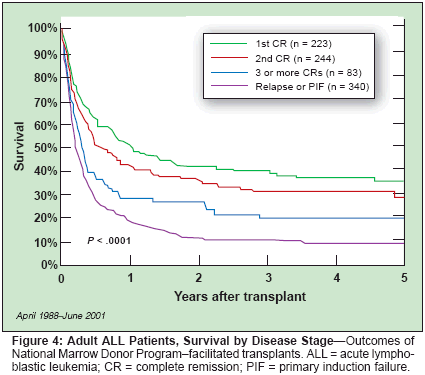
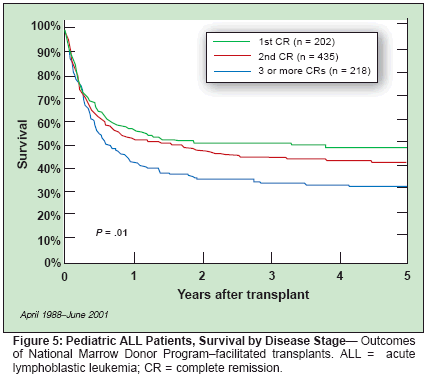
If the preliminary review of theNMDP Registry reveals one or morepotentially matched donors and/or cordblood units, and if the physician andpatient decide to pursue a stem celltransplant, a more formal search of theNMDP Registry can be initiated. Atthis point, charges are assessed to thepatient's transplant center, because aformal search of the NMDP Registryinvolves additional blood tests of volunteerdonors or cord blood units. Onlyphysicians at NMDP-affiliated transplantcenters can perform formalsearches of the NMDP Registry, sothe patient must now be referred to anNMDP-affiliated transplant center ifhe or she is not at one already.Before a transplant can proceed, apotential donor undergoes confirmatorytyping, an additional higher-resolutionHLA typing to confirm theresults of the original HLA typing.To speed this process, the NMDP usesstored blood samples from volunteerdonors whenever possible, but sometimesa fresh blood draw is needed.At this point, a potential marrow orPBSC donor is contacted by phoneby NMDP donor center staff to ensurethat the donor is in good healthand willing to donate. Obtaining aconfirmatory typing result from astored cord blood unit requires sendingan aliquot from the unit to a centrallaboratory under contract withthe NMDP.Once the HLA typing of the donoris confirmed, and if the physician andpatient decide to proceed to transplant,the NMDP arranges for the donor to becounseled about the risks involved inthe donation process. The potential donorreceives a physical exam to ensurehe/she is medically fit to donate. If thepotential donor agrees to donate, theNMDP informs the transplant centerand a donation date is scheduled at anNMDP collection or apheresis centerclosest to where the donor lives.If a cord blood unit is selected, theNMDP arranges for the unit to beshipped to the transplant center in a"dry shipper" that keeps the cordblood at the temperature of liquid nitrogen.The average turnaround timefrom a request to the shipment of acord blood unit is 7 to 10 days.
Selection of Donors/Stem Cell Source
For more than 30 years, bone marrowhas been the standard source ofstem cells used in transplantation. Inthe last decade, however, the use oftwo new sources of stem cells has grownrapidly. There has been a steady increasein the use of allogeneic PBSCs,from 20% of all allogeneic transplantsin 1995 to 40% in 2000. The use ofcord blood has also risen rapidly. Inallogeneic recipients less than 20 yearsof age without sibling donors, the useof cord blood has increased from < 5%in 1995 to 15% in 2000.[15]Depending on their source, stemcells have different kinetics of hematologicrecovery and different probabilitiesof eliciting GVHD. Engraftmentof PBSC is on average faster thanengraftment of marrow or cord bloodstem cells, although incidence and severityof chronic GVHD is typicallygreater in PBSC recipients.[16,17] Cordblood generally has longer engraftmenttimes but leads to a lower incidenceand severity of GVHD.[9,18] Transplantphysicians must therefore considerstem cell source in their donorselection decisions.
Blood Stem Cell Procurement
The NMDP coordinates unrelateddonor stem cell transplant using all threesources of stem cells-bone marrow,PBSC, and umbilical cord blood. Bonemarrow and PBSC are obtained fromthe NMDP Registry of more than4.9 million potential volunteer donors.More than 25,000 umbilical cord bloodunits are available from our growingpartnership with cord blood banks.
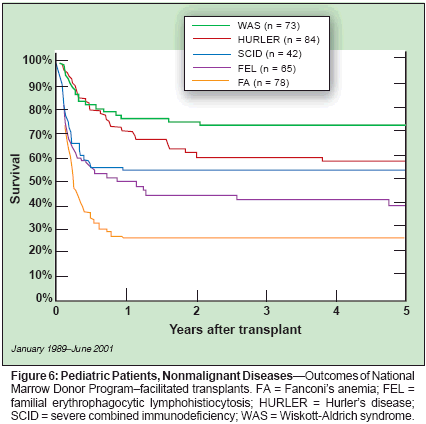
Marrow Harvest
Bone marrow harvest is one methodof obtaining hematopoietic stem cellsperformed at NMDP collection centers.It has been used less frequently inrecent years, since PBSC have becomean alternative source of hematopoieticstem cells. Marrow is harvested fromthe posterior iliac crests while the donoris under general or spinal anesthesia.Large-bore needles are used toaspirate the marrow into syringes rinsedwith a heparin-containing solution. Thecortical bone is penetrated, and 5 to10 mL of marrow is aspirated and trans-ferred to a container with anticoagulantsolution. The aspiration needle is advancedseveral millimeters, rotated90
o
, and the process is repeated.Several aspirations can be madethrough a single bone puncture, andthe bone may be punctured multipletimes from a single skin entry site. Theamount of marrow collected is determinedby the transplant center and isbased on the recipient's weight. However,NMDP regulations prohibit collections> 20 mL/kg of a donor's weight.A typical collection involves 200 to300 marrow aspirations through twoskin incisions.[19] The volume collectedis determined by the nucleated cellcount in the collected marrow and bythe recipient's weight. The target is usually2 to 4 * 10
8
nucleated cells perkilogram of the recipient's weight.[19]Marrow harvests are typically verywell tolerated by donors, although sideeffects such as localized pain, fatigue,and nausea do occur. Serious complicationsare rare. Couriers transport thedonated marrow stem cells to the recipient'stransplant center.
PBSC Collection
Many transplant centers have turnedto PBSC as the primary source of stemcells for allogeneic transplants. A primaryadvantage of the PBSC approachis its rapid and durable trilineage engraftment.Although PBSC are capableof hematopoiesis, peripheral blood inits steady state does not contain adequatenumbers of stem cells to allowfor efficient collection. To collect anadequate number of stem cells in theleast number of apheresis sessions, it isnecessary to stimulate the productionof PBSC through mobilization.Unrelated PBSC collection mustbe performed using regimens that posethe least possible risk to the donor yetprovide the highest quality graft tothe recipient. Mobilization of unrelatedvolunteer donors is performed usinga granulocyte colony-stimulatingfactor (G-CSF, Neupogen). Mosthealthy people can tolerate G-CSFadministered daily at 5 to 10 μg/kg ofdonor weight for 5 to 6 days; higherdoses do not reliably increase the numberof CD34-positive cells and canresult in more severe side effects.[19]Apheresis typically starts on day 4 or5, with a second collection on day 6 ifthe first collection is inadequate.The number of circulating CD34-positive progenitor cells usually peakson day 5 or 6 of G-CSF injections.[20]The extent of stem cells mobilizedand time of peak mobilization canvary widely among individuals. However,sufficient numbers can reliablybe collected from most donors by administeringa single daily dose ofG-CSF at 7 to 10 μg/kg subcutaneouslyfor 4 to 6 days, followed by oneto three apheresis procedures startingon day 3 to 5.[21]Confer et al [22] reported the NMDPexperience of the collection of G-CSFmobilizedPBSC from 395 unrelateddonors. Adverse reactions to G-CSFincluded bone pain (reported by 85%),insomnia (5.8%), headache (5.5%), andmalaise (2.5%). Bone pain is effectivelytreated with over-the-counter analgesics,and all other symptoms resolvedwithin a week of cessation of theG-CSF. The NMDP PBSC collectionprotocol is performed under an INDapplication with the FDA. This enablesthe NMDP to collect data on apheresis,short- and long-term effects of G-CSFadministration in normal donors, andthe efficacy and complications of PBSCtransplantation in recipients.The PBSC are collected by mononuclearcell leukapheresis, usually usinga peripheral intravenous catheter.During a single 3-hour apheresis procedure,approximately 12 L of wholeblood can be processed. The PBSCcollection bag is labeled and taken tothe apheresis center processing laboratory,where the CD34-positive cellcount is obtained. The usual target fortransplantation is 4 to 6 * 10
6
CD34-positive cells per kilogram of the transplantrecipient's weight.[19] A couriertransports the cells from the processinglaboratory to the transplant center.
Cord Blood
Umbilical cord blood contains cellscapable of hematopoiesis. The first successfulumbilical cord blood transplantwas performed in 1988. The early successof cord blood transplant and theongoing need for suitable HLAmatchedunrelated donors led to theestablishment of cord blood banks in1993. The NMDP Registry has morethan 25,000 cord blood units listed.The NMDP cord blood protocol is performedunder an IND from the FDA.The advantages of using unrelatedumbilical cord blood include rapidavailability, absence of donor risk,lower numbers of GVHD-producinglymphocytes, and lower risk of transmittinginfectious diseases such ascytomegalovirus and Epstein-Barr virus.[23] Disadvantages include fewerstem cells in a typical cord blood unit,making this stem cell source less viablefor adult patients. In addition, theoriginal donor is unavailable should asecond donation be required due tograft failure or relapse.Transportation of a cord blood unitto a recipient involves transferring acord blood unit from an NMDPaffiliatedcord blood bank using a"dry shipper" device, the interior ofwhich is -80
o
C or colder.
Unrelated Donor Stem CellTransplantation Outcomes
In the NMDP's analyses of transplantoutcome, the following factorshave been shown to affect the overalllikelihood of recipient survival as wellas other outcome measures such asacute and chronic GVHD and engraftment:diagnosis and stage of disease,degree of HLA match, age of donor,age of recipient, time from diagnosisto transplant, and prior cytomegalovirus(CMV) exposure.The interaction of these factors iscomplex and varies by diagnosis. Ingeneral, improved outcomes are associatedwith shorter disease duration,younger age of both recipient and donor,six-antigen HLA match, and recipientCMV seronegativity. Arepresentative sample of outcomes ofNMDP-facilitated transplants areshown in Figures 3 through 6.
Posttransplant Follow-up
The NMDP remains involved withunrelated donor transplant recipientsfollowing the transplant. The NMDPresearch program collects and studiesdata on transplant recipients' successesand complications to learn how toimprove patient outcomes. TheNMDP collects data on each transplantpatient on the day of transplant,100 days posttransplant, 180 daysposttransplant, and annually thereafter.These data are very important inthe NMDP's effort to continue to learnmore about avoiding and treating seriouscomplications and improvingtransplant outcomes.In the United States, there are morethan 20,000 patients who are morethan 5 years posttransplant.[24] Follow-up for these patients takes placemost often in the community setting.It is important that transplant centerseducate patients, families, and communityphysicians about the potentialfor further complications. Close follow-up and rapid intervention whenneeded provide these patients with thebest chance for long-term survival.
Summary
Since its founding in 1986, theNMDP has facilitated more than16,000 transplants for patients withblood disorders such as leukemia andaplastic anemia, as well as immunesystem disorders and genetic disorders.The donors who provided theblood stem cells for these transplantscame from the NMDP Registry, theworld's largest and most diverse registryof potential blood stem cell donors.Initiating a search of the NMDPRegistry for an HLA-matched unrelateddonor is as simple as submittingto the NMDP a patient's HLA typingresults along with basic demographicand disease information.If a suitable donor is identified, theNMDP coordinates the steps neededto bring the donated stem cells-whether they be marrow, PBSC, orcord blood-to a patient. After readingthis article, physicians should havea greater understanding of the complicatedprocess needed to bring aboutan unrelated donor stem cell transplant.A better understanding of therole the NMDP plays in unrelated donorstem cell transplantation reducesthe chances that physicians and patientswill have unrealistic expectationsabout the process.To initiate a preliminary search ofthe NMDP Registry, contact theNMDP Office of Patient Advocacytoll-free at 1-888-999-6743. A preliminarysearch request form can alsobe submitted via the NMDP website:www.marrow.org
References:
1.
Vassiliou G, Amrolia P, Roberts IA: Allogeneictransplantation for haemoglobinopathies.Best Pract Res Clin Haematol14:807-822, 2001.
2.
Hoppe CC, Walters MC: Bone marrowtransplantation in sickle cell anemia. Curr OpinOncol 13:85-90, 2001.
3.
Bregni M, Dodero A, Peccatori J, et al:Nonmyeloablative conditioning followed byhematopoietic cell allografting and donor lymphocyteinfusions for patients with metastaticrenal and breast cancer. Blood 99:4234-4236,2002.
4.
Ueno NT, Rondon G, Mizra NQ, et al:Allogeneic peripheral-blood progenitor-celltransplantation for poor-risk patients with metastaticbreast cancer. J Clin Oncol 16:986-993, 1998.
5.
Childs R, Chernoff A, Contentin N, et al:Regression of metastatic renal-cell carcinomaafter nonmyeloablative allogeneic peripheralbloodstem-cell transplantation. N Engl J Med343: 750-758, 2000.
6.
Klein J, Sato A: Advances in immunology:The HLA system-First of two parts. NEngl J Med 343:702-709, 2000.
7.
Wagner JE, Barker JN, DeFor TE, et al:Transplantation of unrelated donor umbilicalcord blood in 102 patients with malignant andnonmalignant diseases. Blood 100:1611-1618,2002.
8.
Cairo MS, Wagner JE: Placental and/orumbilical cord blood: An alternative source ofhematopoietic stem cells for transplantation.Blood 90:4665-4678, 1997.
9.
Rubinstein P, Carrier C, Scaradavou A,et al: Outcomes among 562 recipients of placental-blood transplants from unrelated donors.N Engl J Med 339:1565-1577, 1998.
10.
Hurley CK, Wade JA, Oudshoorn M, etal: A special report: Histocompatibility testingguidelines for hematopoietic stem cell transplantationusing volunteer donors. Tissue AnAntigens53(4 pt 1):394-406, 1999.
11.
Petersdorf EW, Mickelson EM, AnasettiC, et al: Effect of HLA mismatches on theoutcome of hematopoietic transplants. CurrOpin Immunol 11:521-526, 1999.
12.
Thomas ED: Bone marrow transplantation:A review. Semin Hematol 36(4 suppl7):95-103, 1999.
13.
Petersdorf EW, Longton GM, AnasettiC, et al: Association of HLA-C disparity withgraft failure after marrow transplantationfrom unrelated donors. Blood 89:1818-1823,1997.
14.
Petersdorf EW, Gooley TA, Anasetti C,et al: Optimizing outcome after unrelated marrowtransplantation by comprehensive matchingof HLA class I and II alleles in the donorand recipient. Blood 92:3515-3520, 1998.
15.
Data from the International Bone MarrowTransplant Registry (IBMTR). Availableat www.ibmtr.org.
16.
Ringdén O, Remberger M, Runde V, etal: Peripheral blood stem cell transplantationfrom unrelated donors: A comparison withmarrow transplantation. Blood 94:455-464,1999.
17.
Storek J, Gooley T, Siadak M, et al:Allogeneic peripheral blood stem cell transplantationmay be associated with a high riskof chronic graft-versus-host disease. Blood90:4705-4709, 1997.
18.
Gluckman E, Rocha V, Boyer-ChammardA, et al: Outcome of cord-blood transplantationfrom related and unrelated donors.N Engl J Med 337:373-381, 1997.
19.
Confer DL, Stroncek DF: Bone marrowand peripheral blood stem cell donors, in ThomasED, Blume KG, Forman SJ (eds): HematopoieticStem Cell Transplantation, 2nded, pp 421-430. Oxford, England, Blackwell,1999.
20.
Anderlini P, Körbling M, Dale D, et al:Allogeneic blood stem cell transplantation:considerations for donors. Blood 90:903-908,1997.
21.
Lane TA: Peripheral blood progenitorcell mobilization and collection, in Ball ED,Lister J, Law P (eds): Hematopoietic StemCell Therapy, pp 269-286. Philadelphia,Churchill Livingstone, 2000.
22.
Confer DL, Haagenso M, Anderlini P,et al: Collection of rhG-GCSF mobilized bloodstem cells from 395 unrelated donors (abstract).American Society of Hematology 43rd AnnualMeeting, 2001.
23.
McCullough J, Clay M, Wagner JE:Cord blood stem cells, in Ball ED, Lister J,Law P (eds): Hematopoietic Stem Cell Therapy,New York, Churchill Livingstone, 2000.
24.
Antin JA: Long-term care after hematopoietic-cell transplantation in adults. N Engl JMed 347:36-42, 2002
Oncology Peer Review On-The-Go: Cancer-Related Fatigue Outcome Measures in Integrative Oncology
September 20th 2022Authors Dori Beeler, PhD; Shelley Wang, MD, MPH; and Viraj A. Master, MD, PhD, spoke with CancerNetwork® about a review article on cancer-related fatigue published in the journal ONCOLOGY®.
Oncology Peer Review On-The-Go: Cancer-Related Fatigue Outcome Measures in Integrative Oncology
September 20th 2022Authors Dori Beeler, PhD; Shelley Wang, MD, MPH; and Viraj A. Master, MD, PhD, spoke with CancerNetwork® about a review article on cancer-related fatigue published in the journal ONCOLOGY®.
2 Commerce Drive
Cranbury, NJ 08512
All rights reserved.